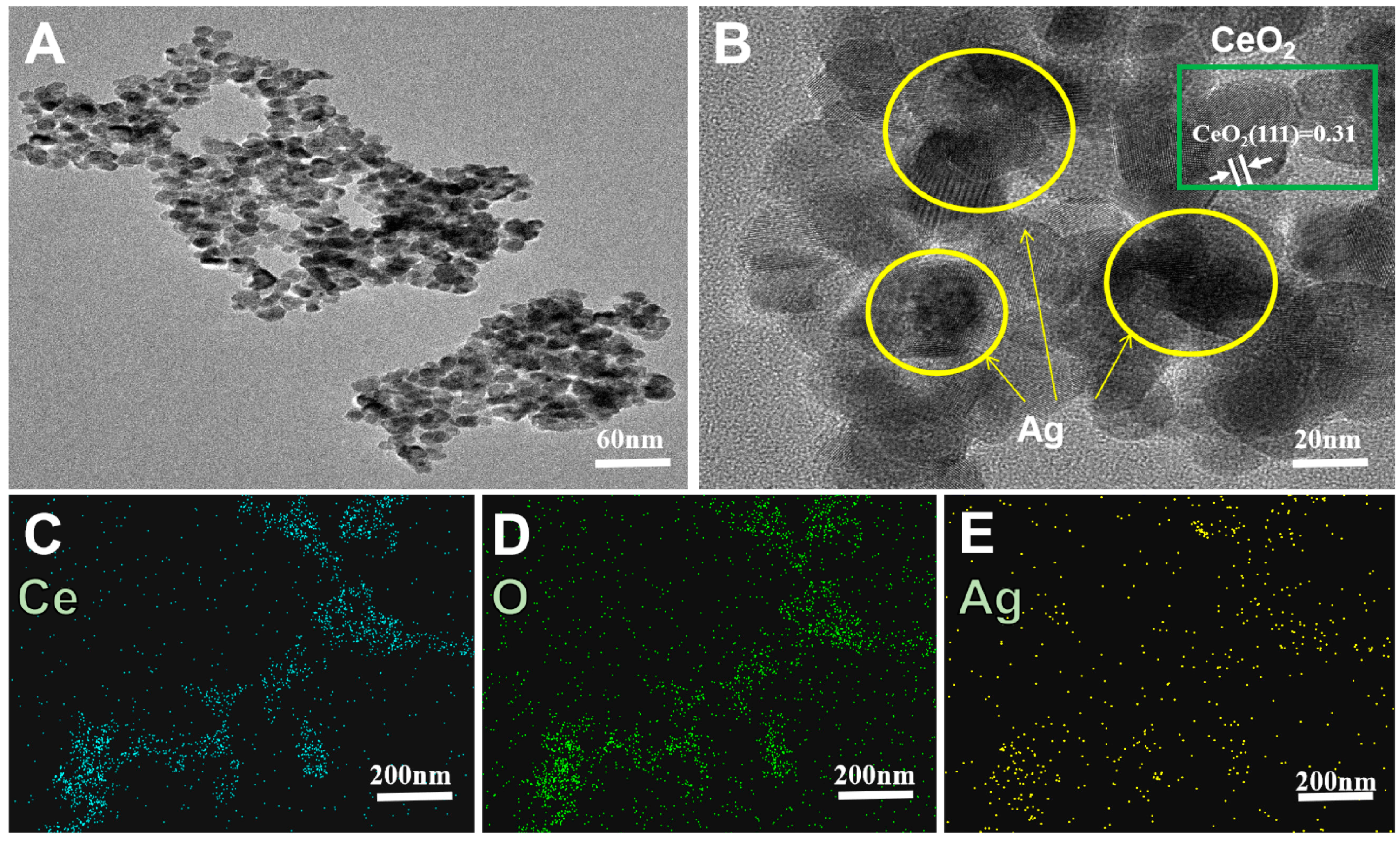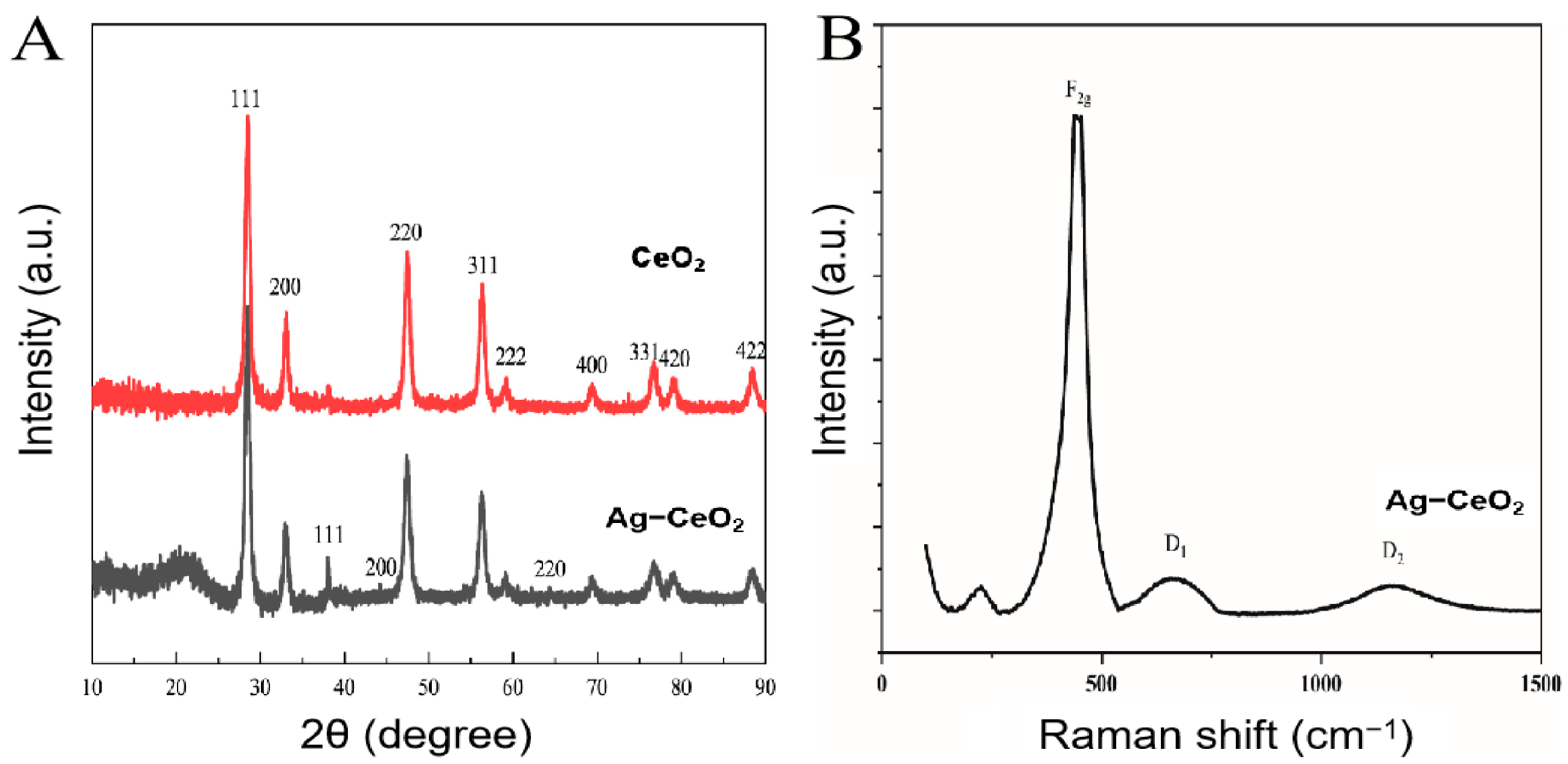Ag-CeO2 Based on Electrochemical Sensor for High-Efficient On-Site Detection of Nitrite in Aquaculture Water and Beverages
Abstract
:1. Introduction
2. Results and Discussion
2.1. Characterization of Ag-CeO2 Nanoparticles
2.2. Fabrication of Ag-CeO2 Based on an Electrochemical Sensor
2.3. Investigation of the Electrochemical Behavior and Mechanism
2.4. Electrochemical Determination of Nitrite
2.5. Real Sample Analysis
3. Materials and Methods
3.1. Chemicals
3.2. Preparation and Characterization of Ag-CeO2
3.3. Fabrication of the Modified Electrode
3.4. Real Samples Analysis by Electrochemical Measurements
4. Conclusions
Author Contributions
Funding
Institutional Review Board Statement
Informed Consent Statement
Data Availability Statement
Conflicts of Interest
References
- Xiong, X.; Guo, C.; Yan, G. Simultaneous cross-type detection of water quality indexes via a smartphone-app integrated microfluidic paper-based platform. J. ACS Omega 2022, 7, 44338–44345. [Google Scholar] [CrossRef] [PubMed]
- Karwowska, M.; Kononiuk, A. Nitrates/nitrites in food—Risk for nitrosative stress and benefits. J. Antioxid. 2020, 9, 241. [Google Scholar] [CrossRef] [PubMed]
- Chazelas, E.; Pierre, F.; Druesne-Pecollo, N. Nitrites and nitrates from food additives and cancer risk: Results from the NutriNet-Santé cohort. J. Eur. J. Public Health 2021, 31, 165–244. [Google Scholar] [CrossRef]
- Liang, M.; Gao, Y.; Sun, X. Metal-organic framework-based ratiometric point-of-care testing for quantitative visual detection of nitrite. J. Hazard. Mater. 2024, 469, 134021. [Google Scholar] [CrossRef] [PubMed]
- Ibrahim, M.H.; Xue, Z.; Abdu, H.I. Sensitive and selective colorimetric nitrite ion assay using silver nanoparticles easily synthesized and stabilized by AHNDMS and functionalized with PABA. J. Nanoscale Adv. 2019, 1, 1207–1214. [Google Scholar] [CrossRef] [PubMed]
- Chen, L.; Fan, T.; Li, W. A turn-on fluorescent nano-probe base on methanobactin-AuNPs for simple and efficient detection of nitrite. J. Spectrochim. Acta Part A Mol. Biomol. Spectrosc. 2023, 286, 121960. [Google Scholar] [CrossRef] [PubMed]
- Xian, L.; You, R.; Zhang, J. Preparation of urea-modified graphene oxide-gold composite detection of nitrite. J. Appl. Surf. Sci. 2022, 152917. [Google Scholar] [CrossRef]
- Shi, Y.; Liu, H.L.; Zhu, X.Q. Optofluidic differential colorimetry for rapid nitrite determination. J. Lab A Chip 2018, 18, 2994–3002. [Google Scholar] [CrossRef] [PubMed]
- Lin, X.; Su, J.; Zhou, S. Microfluidic chip of concentration gradient and fluid shear stress on a single cell level. J. Chin. Chem. Lett. 2022, 33, 3133–3138. [Google Scholar] [CrossRef]
- Sun, Y.; Xu, H.; Zhou, D. A Portable Integrated Electrochemical Sensing System for On-Site Nitrite Detection in Food. J. Small 2023, 2309357. [Google Scholar] [CrossRef]
- Tatarczak-Michalewska, M.; Flieger, J.; Kawka, J. HPLC-DAD determination of nitrite and nitrate in human saliva utilizing a phosphatidylcholine column. J. Mol. 2019, 24, 1754. [Google Scholar] [CrossRef] [PubMed]
- Liu, Q.; Wen, G.; Zhao, D. Nitrite reduction over Ag nanoarray electrocatalyst for ammonia synthesis. J. Colloid Interface Sci. 2022, 623, 513–519. [Google Scholar] [CrossRef]
- Chavez, M.E.; Biset-Peiró, M.; Murcia-López, S. Cu2O–Cu@ Titanium Surface with Synergistic Performance for Nitrate-to-Ammonia Electrochemical Reduction. J. ACS Sustain. Chem. Eng. 2023, 11, 3633–3643. [Google Scholar] [CrossRef] [PubMed]
- Yi, H.; Tan, L.; Xia, L. Ce-modified LiNi0.5Co0.2Mn0.3O2 cathode with enhanced surface and structural stability for Li ion batteries. J. Adv. Powder Technol. 2021, 32, 2493–2501. [Google Scholar] [CrossRef]
- Lu, L. Highly sensitive detection of nitrite at a novel electrochemical sensor based on mutually stabilized Pt nanoclusters doped CoO nanohybrid. J. Sens. Actuators B: Chem. 2019, 281, 182–190. [Google Scholar] [CrossRef]
- Zhang, M.; Hai, H.; Liang, X. A novel electrochemical sensor based on Au-Dy2(WO4)3 nanocomposites for simultaneous determination of uric acid and nitrite. J. Chin. J. Anal. Chem. 2020, 48, e20032–e20037. [Google Scholar] [CrossRef]
- Manibalan, G.; Murugadoss, G.; Thangamuthu, R. High electrochemical performance and enhanced electrocatalytic behavior of a hydrothermally synthesized highly crystalline heterostructure CeO2@NiO nanocomposite. J. Inorg. Chem. 2019, 58, 13843–13861. [Google Scholar] [CrossRef] [PubMed]
- Rudayni, H.A.; Chaudhary, A.A.; Abu-Taweel, G.M. Hydrothermal synthesis of CeO2 nanoparticles and its application in electrochemical detection of nitrofurantoin antibiotics. J. Europhys. Lett. 2022, 137, 66005. [Google Scholar] [CrossRef]
- Liu, H.; Zhu, Y.; Ma, J. Hydrothermal synthesis of Pd-doped CeO2 nanomaterials and electrochemical detection for phenol. J. Cryst. Growth 2022, 586, 126626. [Google Scholar] [CrossRef]
- Prasad, G.V.; Jang, S.J.; Sekhar, Y.C. Fine-tuning of Pd–CeO2/rGO nanocomposite: A facile synergetic strategy for effective electrochemical detection of dopamine in pharmaceutical and biological samples. J. Electroanal. Chem. 2023, 941, 117544. [Google Scholar] [CrossRef]
- Yu, S.; Yue, Z.; Wang, X. PTA/CeO2@Pt-based electrochemical sensors to detect xanthine and uric acid, and evaluate fish freshness. J. Chem. Eng. J. 2024, 151646. [Google Scholar] [CrossRef]
- Yin, H.; Zhang, C.; Wang, Z. A novel sensor based on P-Ru/NC for sensitive electrochemical detection of H2O2. J. Alloys Compd. 2023, 968, 171949. [Google Scholar] [CrossRef]
- Wang, Y.; Ding, L.; Yu, H. Cucurbit [6] uril functionalized gold nanoparticles and electrode for the detection of metformin drug. J. Chin. Chem. Lett. 2022, 33, 283–287. [Google Scholar] [CrossRef]
- Ahmad, R.; Mahmoudi, T.; Ahn, M.S. Fabrication of sensitive non-enzymatic nitrite sensor using silver-reduced graphene oxide nanocomposite. J. Colloid Interface Sci. 2018, 516, 67–75. [Google Scholar] [CrossRef]
- Doğan, H.Ö.; Albayrak, Ö.F. Ag nanoparticles-decorated CuBi2O4-rGO electrodes as an amperometric sensor for electrochemical determination of nitrite. J. Synth. Met. 2023, 298, 117445. [Google Scholar] [CrossRef]
- Khan, M.; Ansari, S.A.; Lee, J.H. Electrochemically active biofilm assisted synthesis of Ag@CeO2 nanocomposites for antimicrobial activity, photocatalysis and photoelectrodes. J. Colloid Interface Sci. 2014, 431, 255–263. [Google Scholar] [CrossRef]
- Nouri, M.; Rahimnejad, M.; Najafpour, G. Fabrication of an ultra-sensitive electrochemical DNA biosensor based on CT-DNA/NiFe2O4NPs/Au/CPE for detecting rizatriptan benzoate. J. Environ. Res. 2023, 236, 116801. [Google Scholar] [CrossRef]
- Nithyayini, K.N.; Harish, M.N.K.; Nagashree, K.L. Electrochemical detection of nitrite at NiFe2O4 nanoparticles synthesised by solvent deficient method. J. Electrochim. Acta 2019, 317, 701–710. [Google Scholar] [CrossRef]
- Pontie, M.; Foukmeniok Mbokou, S.; Dron, J. Development of unmodified and CTAB-modified carbon paste electrodes (CPE) for direct electrochemical analysis of nitrites in aquarium water and rat blood. J. Appl. Electrochem. 2023, 53, 1701–1713. [Google Scholar] [CrossRef]
- Ansari, A.A.; Alam, M.; Ali, M.A. Nanostructured CeO2: Ag platform for electrochemically sensitive detection of nitrophenol. J. Colloids Surf. A: Physicochem. Eng. Asp. 2021, 613, 126116. [Google Scholar] [CrossRef]
- Tian, J.; Sang, Y.; Zhao, Z. Enhanced photocatalytic performances of CeO2/TiO2 nanobelt heterostructures. J. Small 2013, 9, 3864–3872. [Google Scholar] [CrossRef]
- Cao, X.M.; Chen, J.Q.; Zhao, X.R. Facile synthesis of bead-chain structured MWCNTs@CeO2 with oxygen vacancies-rich for promoting electrochemical energy storage. J. Chem. Eng. J. 2024, 479, 147663. [Google Scholar] [CrossRef]
- Kang, Y.; Sun, M.; Li, A. Studies of the catalytic oxidation of CO over Ag/CeO2 catalyst. J. Catal. Lett. 2012, 142, 1498–1504. [Google Scholar] [CrossRef]
- Matussin, S.N.; Harunsani, M.H.; Khan, M.M. CeO2 and CeO2-based nanomaterials for photocatalytic, antioxidant and antimicrobial activities. J. Rare Earths 2023, 41, 167–181. [Google Scholar] [CrossRef]
- Tian, T.; Gao, H.; Zhou, X. Study of the active sites in porous nickel oxide nanosheets by manganese modulation for enhanced oxygen evolution catalysis. J. ACS Energy Lett. 2018, 3, 2150–2158. [Google Scholar] [CrossRef]
- Zhe, T.; Li, M.; Li, F. Integrating electrochemical sensor based on MoO3/Co3O4 heterostructure for highly sensitive sensing of nitrite in sausages and water. J. Food Chem. 2022, 367, 130666. [Google Scholar] [CrossRef] [PubMed]
- Chen, L.; Zheng, J. Two-step hydrothermal and ultrasound-assisted synthesis of CB/NiCo2S4@CeO2 composites for high-sensitivity electrochemical detection of nitrite. J. Microchem. J. 2022, 181, 107717. [Google Scholar] [CrossRef]
- Cheng, C.; Zhang, Y.; Chen, H. Reduced graphene oxide-wrapped La0·8Sr0·2MnO3 microspheres sensing electrode for highly sensitive nitrite detection. J. Talanta 2023, 260, 124644. [Google Scholar] [CrossRef] [PubMed]
- Wang, S.; Xue, Y.; Huang, F. Facet impact of CeO2@ C2D core–shell structure on electrochemical reaction kinetic factor and efficient detection of nitrite. J. Colloid Interface Sci. 2024, 660, 1058–1070. [Google Scholar] [CrossRef]
- Zhang, Y.; Nie, J.; Wei, H. Electrochemical detection of nitrite ions using Ag/Cu/MWNT nanoclusters electrodeposited on a glassy carbon electrode. J. Sens. Actuators B: Chem. 2018, 258, 1107–1116. [Google Scholar] [CrossRef]
- Zhou, L.; Wang, J.P.; Gai, L. An amperometric sensor based on ionic liquid and carbon nanotube modified composite electrode for the determination of nitrite in milk. J. Sens. Actuators B Chem. 2013, 181, 65–70. [Google Scholar] [CrossRef]
- Shi, H.; Fu, L.; Chen, F. Preparation of highly sensitive electrochemical sensor for detection of nitrite in drinking water samples. J. Environ. Res. 2022, 209, 112747. [Google Scholar] [CrossRef]
- GB 5009.33-2016; Chinese Health Ministry. National Food Safety Standard. Determination of Nitrite and Nitrate in Foods. Standards Press of China: Beijing, China, 2016.
- GB 7101-2022; Chinese Health Ministry. National Food Safety Standard. Beverage. Standards Press of China: Beijing, China, 2022.







| Real Samples | Spiked Nitrite (μM) | Detection Nitrite (μM) | Recovery (%) | RSD (%, n = 3) |
|---|---|---|---|---|
| MengNiu Milk | 200 | 195.2 | 97.6 | 0.98 |
| 300 | 293.4 | 97.8 | 1.33 | |
| 400 | 382.4 | 95.6 | 2.92 | |
| ChangFu Milk | 200 | 184.1 | 92.1 | 1.81 |
| 300 | 311.6 | 103.9 | 9.31 | |
| 400 | 407.0 | 101.7 | 0.85 | |
| Fruit Juice | 200 | 205.7 | 102.8 | 1.17 |
| 300 | 328.2 | 101.7 | 0.49 | |
| 400 | 368.9 | 92.2 | 3.27 | |
| Chrysanthemum Tea | 200 | 207.4 | 103.7 | 2.26 |
| 300 | 295.2 | 98.4 | 0.49 | |
| 400 | 403.1 | 100.8 | 4.19 | |
| Evergrands Spring | 200 | 129.7 | 96.4 | 1.17 |
| 300 | 299.6 | 99.8 | 3.11 | |
| 400 | 392.2 | 98.1 | 2.17 | |
| Aquaculture water | 200 | 216.2 | 108.1 | 8.97 |
| 300 | 282.4 | 94.1 | 3.83 | |
| 400 | 424.2 | 106.2 | 2.14 |
Disclaimer/Publisher’s Note: The statements, opinions and data contained in all publications are solely those of the individual author(s) and contributor(s) and not of MDPI and/or the editor(s). MDPI and/or the editor(s) disclaim responsibility for any injury to people or property resulting from any ideas, methods, instructions or products referred to in the content. |
© 2024 by the authors. Licensee MDPI, Basel, Switzerland. This article is an open access article distributed under the terms and conditions of the Creative Commons Attribution (CC BY) license (https://creativecommons.org/licenses/by/4.0/).
Share and Cite
Zhao, K.; Zhang, Z.; Zhou, Y.; Lin, X. Ag-CeO2 Based on Electrochemical Sensor for High-Efficient On-Site Detection of Nitrite in Aquaculture Water and Beverages. Molecules 2024, 29, 2644. https://doi.org/10.3390/molecules29112644
Zhao K, Zhang Z, Zhou Y, Lin X. Ag-CeO2 Based on Electrochemical Sensor for High-Efficient On-Site Detection of Nitrite in Aquaculture Water and Beverages. Molecules. 2024; 29(11):2644. https://doi.org/10.3390/molecules29112644
Chicago/Turabian StyleZhao, Kunmeng, Ziyao Zhang, Yihui Zhou, and Xuexia Lin. 2024. "Ag-CeO2 Based on Electrochemical Sensor for High-Efficient On-Site Detection of Nitrite in Aquaculture Water and Beverages" Molecules 29, no. 11: 2644. https://doi.org/10.3390/molecules29112644






